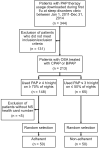Positive airway pressure therapy adherence and outcomes in obstructive sleep apnea: An exploratory longitudinal retrospective randomized chart review
- PMID: 38314346
- PMCID: PMC10838662
- DOI: 10.29390/001c.92080
Positive airway pressure therapy adherence and outcomes in obstructive sleep apnea: An exploratory longitudinal retrospective randomized chart review
Abstract
Background: Positive airway pressure (PAP) therapy is prescribed to patients with obstructive sleep apnea (OSA). A commonly used definition for PAP therapy adherence is based upon the minimum requirements to receive Medicare coverage in the US, defined as PAP usage of four or more hours per night on 70 percent of nights for at least 30 consecutive days. However, little evidence exists to support this definition for PAP therapy adherence. Therefore, the present study sought to determine the efficacy of the present definition of PAP therapy adherence on longitudinal outcomes in patients with OSA, using objectively measured PAP device usage time.
Methods: An exploratory longitudinal, retrospective, randomized chart review was done to assess clinical outcomes between patients with OSA who were defined as PAP therapy adherent (n=50) and non-adherent (n=50) during an eight-year observation period.
Results: No significant differences were shown between groups for mortality, hospitalizations, or development of co-morbidities during the observation period. However, logistic regression showed significantly higher odds of adherence in male patients compared to female patients (OR=8.519; 95%CI=1.301-55.756; p=0.025) and significantly lower odds of adherence in patients with higher normal (OR=0.039; 95%CI=0.005-0.392; p=0.003), mild excessive (OR=0.039; 95%CI=0.003-0.517; p=0.014), and severe excessive (OR=0.088; 95%CI=0.012-0.635; p=0.016) daytime sleepiness compared to patients with lower normal daytime sleepiness. An increasing number of hospitalizations also corresponded with a significant decrease in odds of being adherent (OR=0.741; 95%CI=0.551-0.995; p=0.046).
Conclusion: The present study supports a steadily growing body of literature calling for more consideration and evidence to support a definition of PAP therapy adherence that is clinically meaningful.
Keywords: adherence; mortality; outcomes; positive airway pressure; sleep apnea obstructive.
Conflict of interest statement
The authors have no competing interests to declare that are relevant to the content of this article.
Figures
Similar articles
-
Dose-response relationship between positive airway pressure therapy and excessive daytime sleepiness: the HomePAP study.J Clin Sleep Med. 2022 Apr 1;18(4):1027-1034. doi: 10.5664/jcsm.9792. J Clin Sleep Med. 2022. PMID: 34870587 Free PMC article. Clinical Trial.
-
Positive Airway Pressure Therapy Adherence and Health Care Resource Use in Patients With Obstructive Sleep Apnea and Heart Failure With Preserved Ejection Fraction.J Am Heart Assoc. 2023 Jul 18;12(14):e028733. doi: 10.1161/JAHA.122.028733. Epub 2023 Jul 8. J Am Heart Assoc. 2023. PMID: 37421282 Free PMC article.
-
Influence of excessive daytime sleepiness on the treatment adherence of obstructive sleep apnea.Sleep Med. 2023 Sep;109:50-55. doi: 10.1016/j.sleep.2023.06.015. Epub 2023 Jun 27. Sleep Med. 2023. PMID: 37418827
-
Heated humidification did not improve compliance of positive airway pressure and subjective daytime sleepiness in obstructive sleep apnea syndrome: A meta-analysis.PLoS One. 2018 Dec 5;13(12):e0207994. doi: 10.1371/journal.pone.0207994. eCollection 2018. PLoS One. 2018. PMID: 30517168 Free PMC article.
-
What is a Clinically Meaningful Target for Positive Airway Pressure Adherence?Sleep Med Clin. 2021 Mar;16(1):1-10. doi: 10.1016/j.jsmc.2020.10.001. Epub 2020 Dec 2. Sleep Med Clin. 2021. PMID: 33485522 Review.
Cited by
-
Neuro-Ophthalmological Disorders Associated with Obstructive Sleep Apnoea.Int J Mol Sci. 2025 Jul 11;26(14):6649. doi: 10.3390/ijms26146649. Int J Mol Sci. 2025. PMID: 40724899 Free PMC article. Review.
References
-
- Treatment of adult obstructive sleep apnea with positive airway pressure: An American academy of sleep medicine systematic review, meta-analysis, and GRADE assessment. Patil Susheel P., Ayappa Indu A., Caples Sean M., John Kimoff R., Patel Sanjay R., Harrod Christopher G. Feb 15;2019 Journal of Clinical Sleep Medicine. 15(2):301–334. doi: 10.5664/jcsm.7638. doi: 10.5664/jcsm.7638. - DOI - DOI - PMC - PubMed
-
- Sleep Apnea and Cardiovascular Disease. An American Heart Association/American College of Cardiology Foundation Scientific Statement From the American Heart Association Council for High Blood Pressure Research Professional Education Committee, Council on Clinical Cardiology, Stroke Council, and Council On Cardiovascular Nursing. In collaboration with the National Heart, Lung, and Blood Institute National Centre on Sleep disorders Research (National Institutes of Health) Somers Virend K., White David P., Amin Raouf, Abraham William T., Costa Fernando, Culebras Antonio, Daniels Stephen, Floras John S., Hunt Carl E., Olson Lyle J., Pickering Thomas G., Russell Richard, Woo Mary, Young Terry. Aug;2008 Circulation. 118(10):1080–111. doi: 10.1016/j.jacc.2008.05.002. doi: 10.1016/j.jacc.2008.05.002. - DOI - DOI - PubMed
LinkOut - more resources
Full Text Sources
Research Materials

